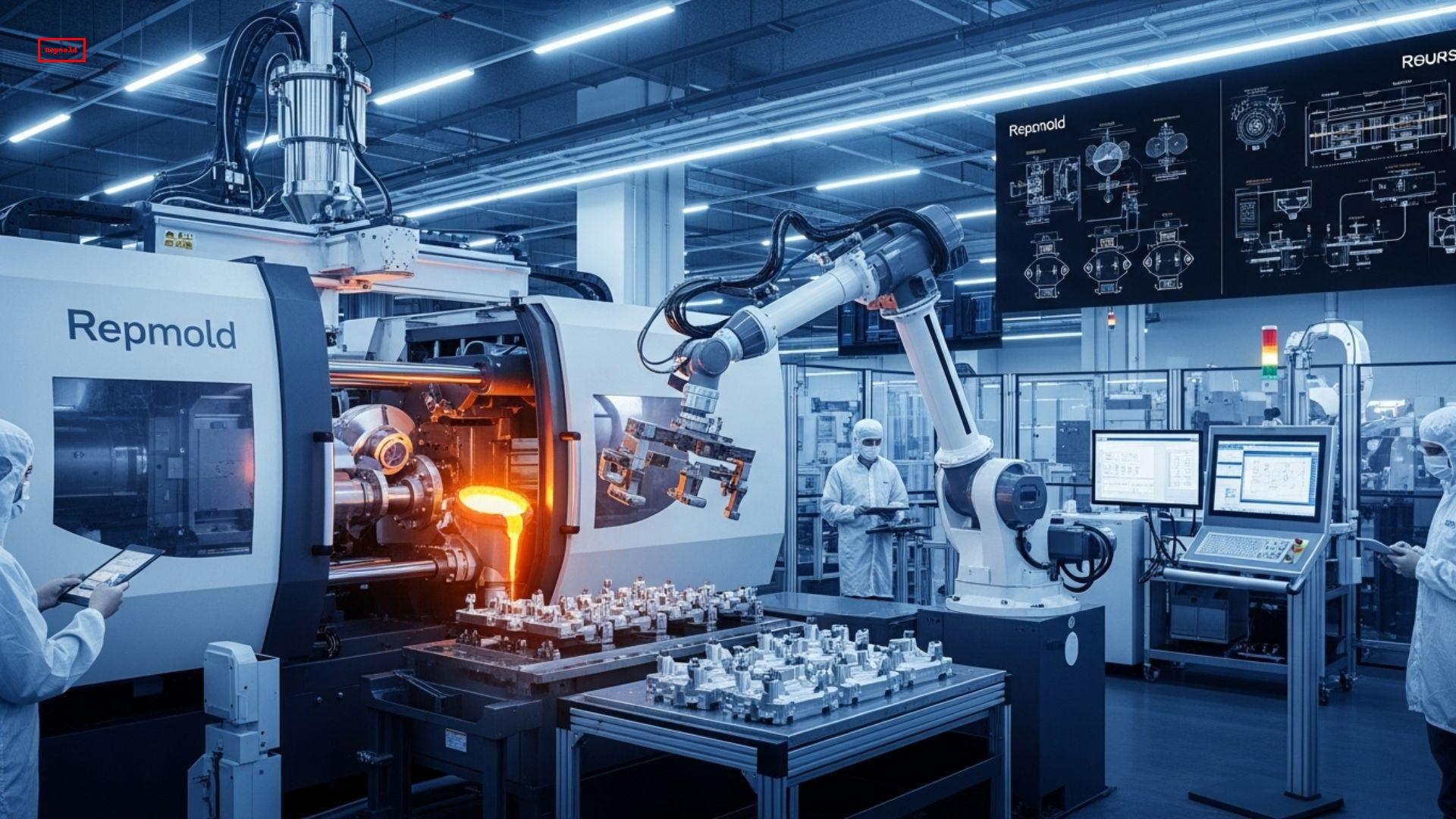There’s this word floating around in manufacturing circles—Repmold. Sounds a bit like a sci-fi robot’s name, right? Or some kind of alien fungus. But it’s short for something way more grounded: rapid prototyping mold, or sometimes replacement mold. Basically, molds are made fast. Thinking about how slow and expensive mold-making used to be feels like a minor miracle.
But let me back up a bit.
The Old Days of Molding
Picture a factory floor in the 1970s: big machines, grease stains, guys in overalls squinting at blueprints. Making a mold for a plastic part could take weeks, sometimes months. Precision milling, polishing, testing—repeat. And if the client changed their mind halfway through? Well, too bad. You’d start again, eat the cost, and pray the next version worked.
Have you ever noticed how many products around us are made of plastic? Your phone case, the pen you chew on, even the cap on your toothpaste—each of those started as an idea, then a prototype, then—yep—a mold. So, in the old days, innovation crawled.
Now fast-forward. Along comes CNC machines, CAD software, and 3D printing. That mold that once took forever could be whipped up in days. That’s where Repmold enters the story.
What Exactly Is Repmold?
In plain words: Repmold is the practice (and sometimes the business) of making molds quickly for prototyping or replacing worn molds. Imagine a startup designing a new water bottle with some funky lid design. Instead of paying $50k and waiting three months for a traditional steel mold, you order a Repmold prototype. A week later, you’re holding test parts in your hand.
It’s not always permanent. These rapid molds might only last a few hundred shots before wearing out. But for testing? For proof-of-concept? Absolute game changer.
And sometimes, it’s not just about speed—it’s about replacement. A production line mold cracks, or old tooling is out of spec. With Repmold, you can duplicate or patch it fast, minimizing downtime.
Honestly, that’s the thing. In manufacturing, downtime is the devil. Every minute the line isn’t running, you’re losing money. Repmold keeps things moving.
Why It Matters More Than People Think
Do you ever wonder why some Kickstarter projects deliver while others vanish into the vapor? Often, it comes down to manufacturing realities. Cool renderings on a laptop are one thing. Genuine, injection-molded parts are another. And that bridge—the prototype mold—decides who sinks and swims.
At a maker fair, I once met a guy who designed a collapsible coffee cup. It was a great idea, with neat little sketches. He crowdfunded and raised tens of thousands. Then… nothing. He admitted later that he got stuck on tooling. The quotes he got were astronomical, and the timelines were crazy. If Repmold services had been more available to him then, who knows? Maybe you’d be drinking out of his cup today.
So yeah, it matters. Repmold democratizes manufacturing in a weird way, giving small players a shot.
The Tools Behind the Magic
Here’s where it gets geeky (in a fun way). How do you actually make a mold “fast”?
- CNC Machining is still the backbone. High-speed mills cut aluminum instead of hardened steel. Aluminum wears faster, but it’s way faster to machine.
- 3D Printing is a big buzzword. You can print a mold insert now, sometimes with exotic resins or metal powders. It’s not perfect, but for a few dozen test shots, it works like a charm.
- Hybrid Approaches: Some companies mix both. They print the cavity and machine the critical surfaces, which is the best of both worlds.
- Digital Simulation: This part’s underrated. Before they cut anything, engineers run mold-flow analysis on a computer. It predicts how molten plastic will behave, where air bubbles will be trapped, and how parts will shrink. This saves tons of trial and error.
Ever tried baking cookies without a proper mold? You guess at the shape, dough leaks out, and half-burnt edges. That’s kind of what mold-making without simulation was like. Trial and error, a lot of wasted dough.
Repmold vs. Traditional Mold
Okay, so what’s the catch? Why doesn’t everyone just do Repmold all the time?
Durability, plain and simple. Traditional steel molds are like tanks—they can crank millions of parts if treated correctly. Repmold versions, especially the aluminum or 3D-printed ones, wear down faster. They’re meant for hundreds or maybe thousands, not millions.
But here’s the trick: most products don’t need millions upfront. You test the market first. You make a few thousand. If it sells, then you invest in the big steel tooling. It’s like dating before marriage.
Repmold fits flawlessly in today’s fast startups, quick pivots, and consumer tastes that change overnight.
The Human Side of It
There’s also something deeply human about this. People want to touch ideas. Designers can stare at a CAD screen for weeks, but it doesn’t feel real until they hold a part. Repmold brings ideas into the physical world quicker than the brain can second-guess them.
I remember visiting a small design studio in Chicago. There were a couple of scrappy engineers, pizza boxes on desks, and a shelf lined with prototype parts—clips, handles, weird hinges—each from a different Repmold run. They laughed, held up a warped piece, and said, “Yeah, that one failed big time, but it got us here.” That’s the magic: fail fast, fail cheap, learn, move.
Industries That Love Repmold
- Automotive: Testing clips, interior panels, knobs. Cars are full of plastic.
- Medical Devices: Imagine quickly needing a new prototype for a syringe design. You don’t wait months. Lives are on the line.
- Consumer Goods: Toys, gadgets, kitchen tools. The stuff we actually buy every day.
- Aerospace: Smaller batch runs, lightweight experimental parts.
Repmold sneaks in pretty much everywhere plastic parts exist.
Repmold and Sustainability
Now, here’s a tangent. What about waste? Isn’t making short-life molds bad for the planet? Depends on how you see it.
Yes, rapid molds often get scrapped faster. But they also prevent massive waste from producing complete production runs of products nobody wants. It’s better to mold 500 test pieces, realize the flaw, and stop than to churn out 50,000 duds.
Also, some Repmold shops recycle their aluminum. Some even experiment with bio-based 3D printing resins. It’s not perfect, but hey, neither is mass manufacturing.
The Future of Repmold
Here’s my guess: Within ten years, we’ll see more distributed Repmold shops—like cloud kitchens but for molding. You send a CAD file, a local shop prints/cuts your mold, runs the shots, and ships them in days. It’s already happening, but it’s just not evenly spread.
AI-driven design tweaks will also speed things up. Imagine software that adjusts your mold design automatically for shrinkage, cooling, and the best fill pattern. Humans check it, machines cut it, and boom—parts on your desk next week.
Ever thought about 3D printing molds right in your office? That’s coming too. It’s already real, not for every material, but for soft plastics, silicones, and small runs.
FAQs About Repmold
Q: Is Repmold the same as 3D printing parts directly?
Not really. 3D printing makes the part layer by layer. Repmold makes the mold, then injection molds the parts. The latter is closer to real production, which is essential for testing.
Q: How long does a Repmold last?
It depends. Aluminum might last a few thousand shots. Printed resins, maybe a few dozen to a hundred—enough for prototypes.
Q: Is it cheaper?
Almost always for small runs. Instead of $50k, you might spend $5k–$10k. Still money, but way more manageable.
Q: Can big companies use it?
Absolutely. In fact, they do all the time. Even automotive giants use Repmold for testing before committing to steel.
Q: Does it replace traditional tooling?
No. Think of it as a bridge, not a replacement. You use Repmold to get there faster, then invest in permanent tooling once the design is solid.
Wrapping It Up (Kinda Messy, Like Real Life)
Repmold isn’t glamorous. You won’t see TikTok influencers talking about it. It’s industrial, a bit greasy, and sometimes frustrating. But it’s also one of those quiet revolutions shaping the stuff in our hands daily.
Whenever you hold a new gadget, a clever kitchen tool, or even a redesigned toothbrush, there’s a decent chance a Repmold prototype was part of its journey.
And maybe that’s the best way to see it—not as some obscure manufacturing term but as this behind-the-scenes enabler, like a stagehand in a theater, moving props, changing sets, and making sure the play goes smoothly.
Without Repmold, ideas stay stuck on screens. With it, they get to breathe. And that’s the point.




